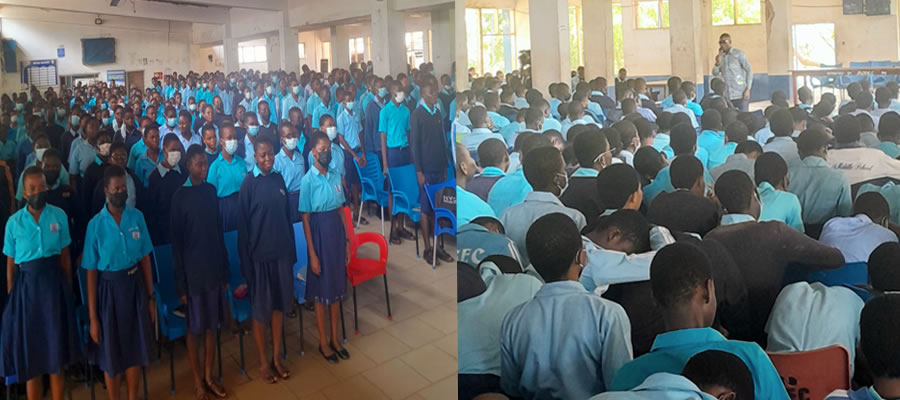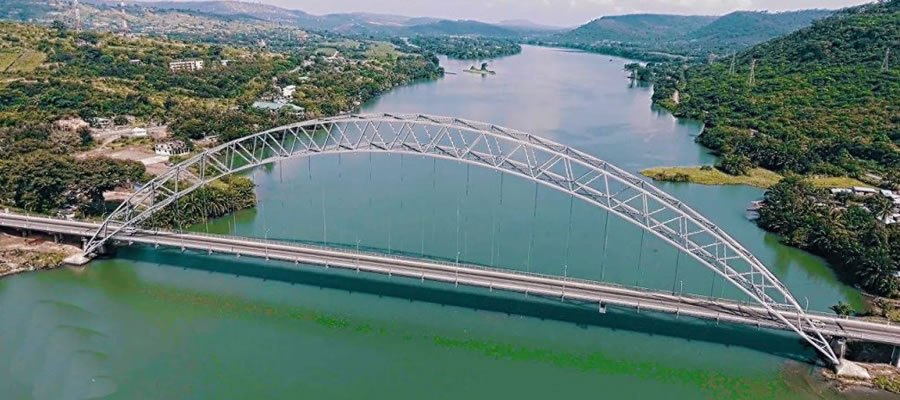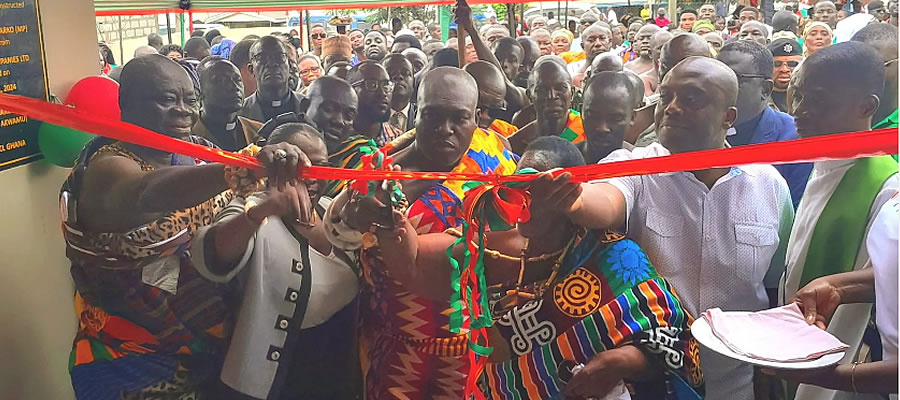

Agriculture is the major economic activity in the district in terms of employment and rural income generation. About 81 percent of the working population is engaged in this sector which constitutes the main source of household income in the district.
There are three (3) prominent types of farming activities in the district. These are livestock farming, food and cash cropping. The most predominant of these is food cropping which constitute more than 78 percent of the farmers in the district. Livestock farming is carried out on a limited scale employing only about 8 percent of farmers whiles cash cropping also employs just about 12 percent of the farming population. An urban community in Ghana is defined as a community with a population of 5,000 people and above. Based on this criterion, few settlements within the Asuogyaman district can be classified as urban.
These settlements can mainly be found along the New Akrade – Akosombo and the Atimpoku and Anum road corridors. Some of the settlements that can be classified as urban are; Anum, Boso, Apeguso, Frankadua, Akosombo and Atimpoku. The Asuogyaman District is, however, to a large extent rural in character. In 1970, 18 percent of the population lived in the urban centres. This increased to 25.4 percent in 1984.
The current rural urban split is estimated to be 65%: 35% as compared to a national average of 63.1%: 36.9%. This reveals that the district is rural but has been growing over the years.
Efforts therefore have to be made to create medium order settlements by providing such settlements with relatively higher order services and thus reduce endogenous migration.
Agricultural Potentials
Suitable soil for the cultivation of vegetables both domestic and exotic all year round through irrigation, for export. Suitable soil for cultivation of Banana, Tobacco, Mangoes and Citrus fruits for export. Potential exists in the District for fish, oyster, and lobster farming in the Volta Lake. Potentials exist for commercial fishing in the Volta lake and development of cold stores. Re-development of poultry and livestock farm at Nkwakubew and Mpakadan is another opportunity in agricultural sector in the District yet to be tapped.
Crop Farming
The major food Crops produced in the District is maize, cassava, plantain, vegetable and yam. A large number of these farmers have smallholdings. Most of the farmers engaged in crop farming are also involved in livestock rearing the main system of farming is bush following and inter-cropping is the main method of farming. The main farming areas are Totibo, Domeabra, Mpakadan, Frankadua, Atimpoku, Gyakiti Ankyease and Survey line. There are large track of Land for commercial farming and Agric Business in these areas currently Bio Exotica Company has taken early advantage of this opportunity to producer pineapple on large scale fro export.
Land acquisition is through the contact of family heads, the chief or private landlords. The practise of the abusa and Abunn tenancy agreement is widespread. The size of farm holdings ranges between 1 and 2.9 acres. There is a lot of land fragmentation, which is explained by increasing population and the use of rudimentary implements such as cutlasses which discourages large scale farming. The ban on farming along the Volta Lake also affects the size of farm holding.
The number of agricultural extension officers in the district is grossly inadequate. The extension officer to farmer ratio in the district is 1:6000.The problem of this over stretched extension workers are compounded the lack of transport and other support materials rendering their work very arduous. This partly accounts for the low proportion of farmers using hybrid seeds and agro –chemicals in their farming activities.
Most of the crops are stored using traditional methods, and this is not always efficient. The most common method of storage is by the use of barns. A sizeable number of farmers also use spraying as a method of preserving their produce. The lack of storage facilities force farmers to sell off their produce at very low prices in order to avoid the produce going bad especially so if there is a bumper harvest. The preservation of other crops such as garden egg and tomatoes constitute a most problem of the farmers in the District.
The main source of funding for farming activities in the District is from the individuals (farmers) own savings. The few financial institutions in the District give limited assistance in the form of credit to farmers.
Livestock Farming
The main types of livestock reared in the District are cattle, goats, sheep, poultry and pigs. The table below indicates the predominant animal reared in the District together with the most prevalent diseases that occur amongst these livestock. Most of the livestock farming that goes on the district is on subsistence levels. Also there are two kraals at Asikuma and Nkwakaben.
Livestock/Poultry Characteristics
| Animals |
| Prevalent Diseases |
| Sheep | 3649 | Helminthiasis, Mange, Wound, PPR |
| Goat | 6159 | Dotto, manual, dystokia |
3. | Pig | 147 | PPR |
4. | Poultry | 17,903 | Foul pox, coccidiosis, Hematoizza, |
5. | Cattle | 376 | Gastro-enteritis, Foot and Mouth Disease. |
Source: Authors Survey, 2006.
The main problems affecting farming in the district are
- Low price paid for farmers produce
- Lack of funds
- irregular rainfall
- pest Diseases.
Fishing
Fishing in the Volta Lake which constitutes an important segment of the agriculture sector is done in some communities along the 141km shoreline including parts of the Kpong headwaters. These communities include Dzidzokope, Atimpoku, Abume, Akosombo, Surveyline, Adomi and Dodi Asantekrom.
Fishing is mainly carried out in small wooden- planked canoes which measure about 6m in length. They are mostly operated manually. Larger wooden boats are used transport both passengers and processed fish to and from the marketing centres at the Port (Marine), and Dzemeni in the Volta Region. Fishermen use an assortment of fishing gears as follow:
- Gill net
- Mosquito-Proof seine net
- Traps
- Cast nets Spears
- Hooks
The use of the fishing gears depend on the target fish, which in turn may depend on locality and time. All the gear types have widespread use except the mosquito-proof seine nets, which are exclusively used to sierrathrissa fish (One Mouth Thousand), in the Headpond, near the Akosombo Dam. Sierrathrissa occurs in great abundance near the Akosombo dam.
Besides the use of the approved fishing gears and methods, some fishermen used other fishing gears and method considered illegal and destructive. These are:
• Gill nets made from meshes smaller than the approved 2inches and 3 inches for multi and mono-filament nets, respectively.
• Poisons (Agrochemical, and explosive (Dynamite)
• Abuse of the mosquito -proof seine nets (use for fishing one man thousand), for fishing juveniles of large sized fish, especially, Chrysichthys (blolovi). The illegal and destructive fishing method continually impose great toll on the potentially productive fisheries of the Volta lake system.
Fish Catch
The following fish types are very important in the fishery due to their occurrence in large commercial quantity in the Volta Lake system in the district. They are also highly preferred.
• Tilapia (Apataa)
• Chryrthrissa (One Mouth thousand)
• Synodontis (Gear Box )
• Bagrus (Yarefo)
About 1000 tonnes of fish are produced in the District annually. However, the rampant use of illegal fishing method which selectively exploit juvenile and small fish, or pollute the environment, created the situation whereby an increasingly large proportion of fish catches comprise small sized fish. Ironically, such small sized fish are of less value and yield little income to both the fishermen and the fish dealers.
Fish Processing and Marketing
Fish obtained from the lake is sold, either fresh or processed. The marketing of fish in its various forms, fresh smoked, fried and dried (mainly, One mouth thousand fish on a very small scale), is undertaken by over 600 women in the district especially at Atimpoku.
Fish smoking is carried out in the fishing communities using small traditional ovens, whose capacity are just adequate for the average daily canoe catches of between 10 and 15kg. Large sized Tulip, chrysichtthys, Synodontis and a few others are usually smoked. The smoke fish are transported to nearby markets at Dzemeni Akosombo, Atimpoku and Agormanya.
Small-sized fisher oil-fried. Large quantities of “One mouth Thousand’ fish are oil-fried in Abume Kokontekpedze and Atimpoku. The fried fish are largely sold, together with maize cake (abolo), at vehicle terminuses at Atimpoku and Kpong in the Manya Krobo District. Other fish types which are fried are Tilapia. (Apatta). Prawns (Borlu), and Clams (Adode). Juvenile Chrysichthys (Blolo), fished illegally with mosquito-proof seine nets in and around Akosombo and Atimpoku, are also fried and sold in neighbouring markets outside the district.
Constraints
The fishing industry in the Asuogyaman district is characterised by the following constraints:
(a) Indiscriminate Use of Illegal and destructive Fishing Methods
The indiscriminate use of illegal and destructive fishing methods poses a great threat to the fishing industry, since the potential of the fisheries resource to produce large-sized and highly-priced fish, is undermined. The uncontrolled use of such illegal methods which target juvenile fish has considerably reduced the efficiency of the approved fishing gear. Many fishermen have become discouraged to use the approved gear, and are turning to the use of the illegal and destructive one.
Poor Storage of Processed Fish
Smoked fish are poorly stored because fish processors are unable to provide large capacity ovens to store accumulated fish. The generally poor housing of the fisher folk expose the processed fish to bad weather and pest attacks which degrade the quality of the processed fish. Fish mongers are usually compelled to dispose of processed fish quickly to avoid excessive losses. Fish dealers, therefore, take under advantage of the situation to exploit the fisher folk.
Lack of Basic Amenities/infrastructure
Many of the fishing communities in the Asuogyaman district lack roads, wharfs, clinics, potable water, markets and schools. The fisher folk are, therefore, vulnerable to disease, illiteracy, and economic deprivation.
Inability of Fishermen to obtain Formal Credit
The fishing industry in the district, although, artisan, requires high capital input. A basic complement of fishing equipment and accessories, comprising a small wooden canoe, a few bundles of net, etc., would cost about 800,000. Many fishermen are unable to provide for themselves this huge capital outlay, and are therefore, compelled to obtain credit (in the form of material inputs) from middlemen.
The fishermen are thus obligated to dispose of their daily catch through these middlemen in order to defray their indebtedness. Because the fishermen do not receive cash for the transaction, they fail to provide for such basic need as education, health and housing. This lack of financial control over their own enterprise has resulted in their depraved condition.
Possible Intervention by the Assembly
A large proportion of the population in the district depend directly on fishing for their livelihood. It behoves the Asuogyaman District Assembly to intervene in the following areas to facilitate the development of the fishers’ resource and industry, as a whole.
Enactment of Fisheries by-laws and enforcement
The fisheries Department, Akosombo, educates fishermen in the district on the current Fisheries Laws and Regulations of Ghana (PNDC L 256). However, the fishermen continue to flout the laws, especially, regarding the use of illegal fishing gears and methods. Enforcement of the laws, especially, on the water has been difficult because the department is not well equipped to effect arrests of culprits. In addition, the fisher folk have failed to comply with the department in this area.
It is, therefore, being suggested that the Assembly enacts by laws to prohibit the fishing and sale of juvenile fish. In this case, fish dealers could be apprehended when found in possession of such juvenile fish. The Assembly could also pass by-laws to enforce closed seasons, and to prohibit the use of certain destructive fishing gears and methods. Community leaders (chiefs, headmen, chief fishermen, etc.), should be adequately empowered to prosecute cases relating to the fishing industry.
Registration of fishermen and licensing of canoes
The registration of fishermen and licensing of canoes should be undertaken by the assembly, in conjunction with the Fisheries Department. This will facilitate adequate control over the exploitation of the fisheries resource.
Provision of Fish Market and Wharves
A large proportion of the fish produced in the Asuogyaman district is sold in markets outside the district. Important among these external markets are Dzemeni (Volta Region and Agormanya (Manya-Krobo district). Taxes levied on fish sold in these markets do not benefit the Asuogyaman district. It is therefore, important that fish markets are developed in the district where fish trade can be carried out. The fishing beaches in these marketing centres could be developed into wharves to facilitate the berthing of fishing canoes.
Combine Torkor, near Aksosmbo, serves as a marketing centre for fresh One Mouth Thousand fish. It attracts daily, about 100 fish dealers from Akosombo, Atimpoku and Kpong. The fisheries of the Volta lake system in the Asuogyaman district have enormous potential for socio-economic development. Several people are involved in the fishing industry at various levels: fishmongers, fish dealers, fishing gear and equipment suppliers, transports, etc. These people, in turn, have a large number of dependants. The fish caught also improve nutritional standards for the people in the district, and in other regions of the country.
It is, therefore, important to protect and judiciously exploit the fisheries resource in the district. The Asuogyaman District Assembly, which ultimately benefits from the resource, should involve itself in the planning and implementation of fisheries management strategies for the sustainable exploitation of the Volta lake system.
Employment by Sectors
Agriculture, though at subsistence in nature is the predominant occupation in the District. It employs about 52.68 per cent of the total labour force, with the majority of them being in the rural areas. The second major employer in the District is the service sector which engages 44.88 per cent whiles the industrial sector, in its infant stages employs2.44 per cent of the total labour force.
The service sector serves as the main source of employment for the urban populace, partly as a result of the presence of major roads; Accra-Akosombo; Accra-Ho and others, which pass through the urban areas where trading and other service activities are very brisk.
Sector of Economy | Percentage Employed (%) |
Agriculture | 52.68 |
Service | 44.88 |
Industry | 2.44 |
TOTAL 100
Date Created : 11/23/2017 4:44:43 AM












 facebook
facebook
 twitter
twitter
 Youtube
Youtube
 +233 593 831 280
+233 593 831 280 0800 430 430
0800 430 430 GPS: GE-231-4383
GPS: GE-231-4383 info@ghanadistricts.com
info@ghanadistricts.com Box GP1044, Accra, Ghana
Box GP1044, Accra, Ghana